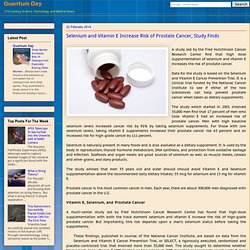

Transcription Factor Discovery Opens Up New Therapies For Glioblastoma Multiforme. Researchers from the Massachusetts General Hospital (MGH) have identified four transcription factors that distinguishes glioblastoma cells.

The four transcription factors identified were POU3F2, SOX2, SALL2 and OLIG2. Transcription factors are proteins that regulates the expression of other genes. In this case, the transcription factors can zero in on a small ratio of glioblastoma cells responsible for the aggressiveness and treatment resistance of the deadly brain tumor. A glioma is a tumor that commonly starts in the brain but can also manifest in the spine. These gliomas are categorized into grades from Grade I to Grade IV. Selenium and Vitamin E Increase Risk of Prostate Cancer, Study Finds. A study led by the Fred Hutchinson Cancer Research Center find that high dose supplementation of selenium and vitamin E increases the risk of prostate cancer.

Data for the study is based on the Selenium and Vitamin E Cancer Prevention Trial. It is a clinical trial funded by the National Cancer Institute to see if either of the two substances can help prevent prostate cancer when taken as dietary supplements The study which started in 2001 involved 35,000 men find that 17 percent of men who took vitamin E had an increased risk of prostate cancer. Men with high baseline selenium levels increased cancer risk by 91% by taking selenium supplements. For those with low selenium levels, taking vitamin E supplements increased their prostate cancer risk 63 percent and an increased risk for high-grade cancer by 111 percent.
Major Advances in Hematopoietic Stem Cell Transplantation Presented At Annual ASH Meeting. Major advances in transplant techniques, strategies, and technologies involving Hematopoietic Stem Cells (HSC) were presented at the 55th American Society of Hematology Annual Meeting and Exposition in New Orleans.

Genetic Discovery Hints at Hereditary Risk of Esophageal Cancer and Barrett's Esophagus. Researchers at the Fred Hutchinson Cancer Research Center and the QIMR Berghofer Medical Research Institute in Australia studied the DNA samples and medical data of more than 8,000 patients and have found four genetic variants in DNA that is associated with increased risk of esophageal cancer and Barrett's esophagus.

Barrett's esophagus is a disorder in which the lining of the esophagus (the tube that carries food from the throat to the stomach) is damaged by stomach acid and changed to a lining similar to that of the stomach. There is a small chance that people afflicted with Barrett's esophagus develop esophageal cancer.
Previously, esophageal cancer and its precursor, Barrett's esophagus are blamed on factors such as obesity, gastroesophageal reflux , smoking and an unhealthy diet. Irreversible Electroporation (IRE) Treatment of Cancer Discussed In Interventional Radiology Gathering. Preliminary studies on the safe benefits of using irreversible electroporation (IRE) in treating cancer are being discussed by doctors and scientists at the Society of Interventional Radiology's 38th Annual Scientific Meeting in New Orleans.

Irreversible Electroporation (IRE) is a technique used to teat soft tissue tumors in hard to access areas of the body such as the liver, lung, pancreas, and prostate. Using electrical energy to target cancerous tumors at the cellular level, irreverssible electroporation is one of the safest options for patients whose tumors may be located in compromised areas such as those near blood vessels or hard to reach organs such as the pancreas. Electrical pulses are used to break open the cellular walls of the tumor causing the cancer cells to die. IRE does not produce any extreme temperatures (hot or cold) but utitlizes the generated electrical field making it safer. Video: Irreversible Electroporation with NanoKnife Technology.
Early Detection of Pancreatic Cancer Through Metabolomic Analysis. A diagnostic test based on metabolites, bio-molecules produced during biological processes, has been developed that can be used as to detect pancreatic cancer in its early stages.

The pancreas is the organ responsible for producing and releasing enzymes needed in the absorption of food. It is also the organ where insulin and glucagon (hormones that help regulate the body's blood sugar) are made. The pancreas is a long gland located behind the abdomen. Possible Treatment of Leukemia Using Monoclonal Antibodies To Target and Destroy Leukemia Cells.
Researchers have identified an antibody that specifically targets and destroys leukemia cells while ignoring normal blood cells.

Leukemia is a type of cancer that affects the blood and bone marrow. The disease causes an abnormal increase of white blood cells and causes abnormalities in the blood, the bone marrow and the lymphoid system. Leukemia starts in the bone marrow where blood cells are produced. The abnormal white blood cells grow faster than normal cells and does not stop growing.
Potential Glioblastoma Treatment Through Mesenchymal Stem Cells Under Study. Researchers have found that stem cells from human fat can be used as a treatment for Glioblastoma.

Glioblastoma multiforme or GBM is the deadliest brain cancer around. It is also the most common. A patient diagnosed with GBM usually has one to two years to live. In GBM, tumors called gliomas start in the brain or spine. Mild forms of GBM is considered Grade I GMB while the most aggressive and deadliest is Grade IV GBM. Using 5 ALA Fluorescence in Surgical Treatment of Glioblastoma Multiforme. The University of California San Francisco describes the use of 5-aminolevulinic acid (5-ALA) fluorescence to aid in visualizing tumor cells and differentiating them from other brain tissue during the surgical treatment of Glioblastoma Multiforme. 5-Aminolevulinic Acid (5-ALA) makes brain tumor cells glow hot pink when illuminated with a special blue light incorporated into an operating microscope during surgery.

The light helps to identify and remove tumor cells in a process called Fluorescent Guided Resection (FGR). Glioblastoma Multiforme (GBM) is the most common and also the deadliest of brain cancers around. This form of cancer is very aggressive and a patient diagnosed with GBM has one to two years to live. The cancerous tumor, called a glioma, starts in the brain or the spine.
Behavioral Stress Accelerates Prostate Cancer Development. Two studies in the Journal of Clinical Investigation focus on behavioral stress and its effect on prostate cancer.

The studies show that stress accelerates prostate cancer.One definition of stress by the American Psychological Association (APA) is that it is any "stress is any uncomfortable emotional experience accompanied by predictable biochemical, physiological and behavioral changes.” There are three kinds of stress according to the APA, Acute Stress, Episodic Acute Stress, and Chronic Stress. Of the three, acute stress is the most common.
This is the type of stress felt from the demands and pressures everyday situations, from the recent past to the near future. Non-Chemotherapy Treatment of Lymphoma Through HDL Cholesterol Deprivation and Nanoparticles. Researchers have discovered a new treatment for lymphoma that does not include drugs or chemotherapy. Researchers at Northwestern Medicine® found that by depriving the lymphoma cell its source of food, which is HDL cholesterol, it will end up starving to death. Lymphoma is a type of cancer that affects the lymphatic or lymph system. The lymphatic system, a major part of the immune system, is a network of organs, lymph nodes, lymph ducts, and lymph vessels in the body. It moves lymph from tissues to the bloodstream. Treating Cancer With Killer T Cells Produced From Induced Pluripotent Stem Cells (iPS)
Japanese researchers at Riken have successfully created cells that will specifically attack cancer cells. These Killer T cells or lymphocytes were developed from induced pluripotent stem cells. New Form of Cell Division Discovered - Klerokinesis. A new form of cell division within cells of the human body has been discovered.
Klerokinesis, the newly discovered process, is believed to be responsible for ensuring that the division is without fault. Cell division is also responsible for replacing and reparing old and damaged tissues. Fundamentally, the definition of cell division is when the parent cell divides into two or more cells known as daughter cells. Nanobiodevice Captures Cancer Cells in Bloodstream. A device based on bionanotechnology has been developed that can capture and release cancer tumor cells present in the blood stream. Nanobiotechnology is the combination of nanotechnology and biology.
It is also known as bionanotechnology and nanobiology (all these terms are interchangeable). The main application of this technology centers around the biological, medical, and the clinical. These applications fall under four fields of biomedical applications. These are for diagnosis, molecular imaging, regenerative medicine, and drug delivery. Cancer Stem Cells From Kidney Tumors Promises New Therapy In Treating The Disease. Cancer stem cells isolated from kidney tumors may give rise to new and effective treatments in treating aggressive forms of the disease.
Stem cell technology has been gaining wide attention because of its potential to treat diseases and conditions that with conventional methods are difficult even impossible. This technology is centered on embryonic and pluripotent stem cells. Fungi Produces Nanoparticles That Can Help Fight Cancer Cells. Study On Beginnings Of Pancreatic Cancer Lead To Early Detection and Treatment.
Clinical Trial Shows GSK2256098 Prevents Spread of Mesothelioma For Patients With Inactive NF2 Gene. A preliminary clinical trial shows that a new drug, GSK2256098 was successful in preventing the spread of mesothelioma in patients with an inactive NF2 gene. MIT News: Understanding Tumor Metastasis, Cancer, And Cellular Adhesion.
Cancer researchers at MIT are focusing their attention on how tumor metastasis occurs. Debate Focuses On Use Of Aspirin In Prevention And Treatment Colorectal Cancer. Aspirin is a very popular drug that is used as a pain killer, anti-inflammatory, and even in managing heart disease through its blood thinning properties. Now, evidence suggests that it can also be used to treat and manage colon cancer. A study by the Harvard Medical School and Massachusetts General Hospital has shown that colon cancer patients who took 325 milligrams (mg) of aspirin twice a week lowered the risk of dying from colon cancer by 30% compard to those who did not take aspirin.
Researchers Develop Breath Analyzing Test To Diagnose Malignant and Benign Pulmonary Nodules. Pulmonary nodules or lung nodules are small masses of tissues in the lung. These nodules are common and are usually benign. Observational Study On Link Between Daily Aspirin Use And Reduced Cancer Mortality. Aspirin is a drug that is used as a pain killer (analgesic) and a fever reducer (antipyretic).
It also has anti-inflammatory properties. Improving Virus-Based Cancer Therapy Based on Oncolytic Viruses. Findings Suggest That RNA Molecule microRNA-122 (miR-122) Linked To Liver Cancer. High Sun Exposure Lowers Risk For Pancreatic Cancer. Pancreatic cancer is known as the silent killer. Early stages of this disease does not cause any symptoms and the middle stage symptoms are usually varied and not specific.
Only until the disease has far advanced that it is diagnosed. The disease garnered public attention when Dirty Dancing actor Patrick Swayze and Apple Founder and CEO Steve Jobs both suffered pancreatic cancer. Findings Show American Ginseng (Panax Quinquefolius) Reduce Fatigue In Cancer Patients With No Side Effects. Watching Instructional Video About Colonoscopy Improves Screening Attendance. Use of Gene Modified Blood Stem Cells Counteracts Toxic Effects of Chemotherapy. Study on Curcumin in Curry And It's Benefits Against Cancer. Lymphoma Therapy Targeting CD19 Protein May Reduce Risk of Lymphoma.
Oregano As Herbal Treatment For Prostate Cancer. Brain Cancer Vaccine, Autologous Heat Shock Protein Peptide Complex 96 (HSPPC-96) Vaccine , Against Glioblastoma Multiforme Proves Effective. Irreversible Electroporation (IRE) With NanoKnife Technology May Provide Cure for Pancreatic Cancer. New Imaging Technique Photoacoustic Tomography Ready For Clinical Use. Nanobiodevice Consisting of Pond Scum Microbe, Euglena, Used To Detect Cancer. Cancer Cell Line Encyclopedia Available To Public. Coffee and Exercise May Help Protect Against Skin Cancer. Cancer Vaccine Based on Cancer Stem Cell Being Developed. Cholesterol Drug Helps Chemotherapy Research in Effectively Treating Cancer. Exposure to Arsenic Can Turn Normal Stem Cells to Cancer Stem Cells.
New Stem Cell Line Offers Safe and Prolific Source for Disease and Transplant Studies. Nanomedicine Cancer Drug To Treat Solid Tumors Ready for Human Trials. Anti Cancer Drug Rapamycin (Sirolimus) Can Cause Diabetes. Endovascular Aneurysm Repair (EVAR) Provides Safe and Effective Aneurysm Treatment.